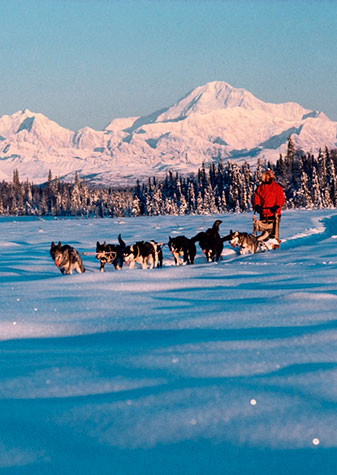The Iditarod Trail Sled Dog Race is the most popular sporting event in Alaska and is the event best known to citizens of the Lower 48 and internationally. Each March when the rugged race departs Anchorage for Nome 1,000 miles away, it serves as a rallying point for Alaskans. Called “The Last Great Race on Earth” by many, the Iditarod, named for an abandoned mining town, crosses forbidding terrain in often frigid weather.
Begun in 1973 through the diligent efforts of Joe Redington Sr., Dorothy Page and a cast of volunteers, the Iditarod owes its inspiration and roots to the 1925 diphtheria run that brought life-saving medicine to the children of Nome by dog team. That challenge in bitter weather that grounded airplanes made heroes out of sled dogs Balto and Togo and the mushers who braved the elements.
The Iditarod is a throwback to olden times. It makes folk heroes out of all mushers and dogs who complete the National Historic Trail. In Anchorage, the state’s biggest city, the teams are given a celebratory sendoff by thousands of spectators. Then come the small, enthusiastic checkpoint villages of Nikolai, McGrath, Unalakleet, Shaktoolik, Golovin and more, all stopovers interrupting lonely miles of trail. The end-of-the-race party on Nome’s Front Street under the legendary burled arch finish line renews itself with each finisher, day or night.
The first Iditarod raced off into the unknown, and it took competitors three weeks to a month to complete the inaugural run. Faster and better-fed dogs, better-trained mushers, improved grooming of trails and more sophisticated equipment have brought the race record down to 8 1/2 days.
Iditarod champions and competitors like Rick Swenson, Susan Butcher, Doug Swingley, Jeff King, Martin Buser, Norman Vaughan, Libby Riddles, DeeDee Jonrowe, Mike Williams, Lance Mackey, Herbie Nayokpuk and Dick Mackey are branded in Alaska lore. Each year, when the race begins anew, old friends reappear and a fresh group of mushers is introduced to the public.
And then for the next 10 days, Alaskans remain captivated by reports updated around the clock as mushers and dogs seek to tame the harsh elements of winter.
– Lew Freedman

